Selecting the right bottle for your baby
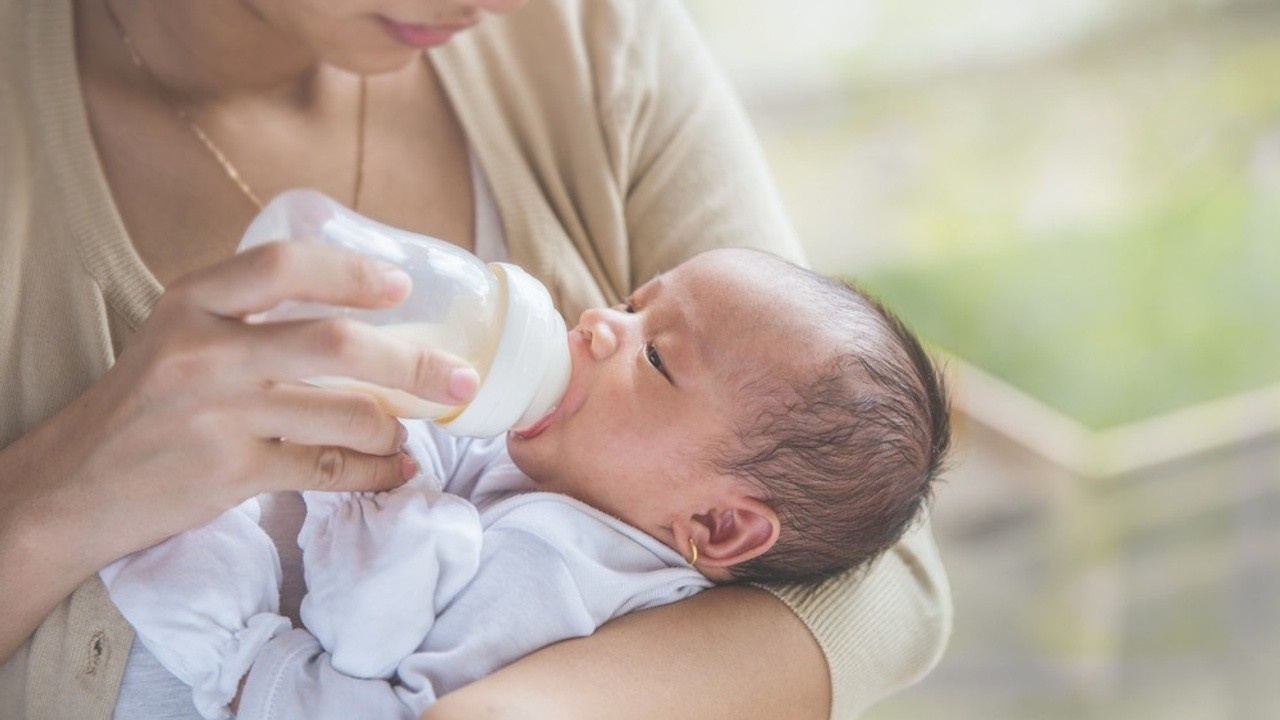
Feeding babies is big business. There are many different companies vying for a coveted position on your shelves and in your wallet. This makes selecting the right bottle for your baby feel anything but easy. With this how-to guide, you can become a savvy bottle shopper and avoid some of the most common (and expensive) mistakes that new parents make when it comes to selecting bottles for their new baby.
TIP # 1 - RECOGNIZE THE MARKETING TRAP.
Marketing experts are banking on the fact that you will do anything and everything to provide the best start for your baby, and their companies know that most parents’ feeding goals include breast/chestfeeding their baby. Advertising their product to be “more like breastfeeding” makes you emotionally connect their product as your ‘best’ choice.
Phrases like “Closer to the Breast”, “More like breastfeeding”, or “Designed for a Breastfeeding Baby”, are highly successful marketing strategies, and you will see them everywhere, now that you know to look.
Most of these products base their claims solely on the outward appearance of their bottles. Much like a breast/chest, they have a wide base and a tall nipple. If you bought your bottles because of this language, you are not alone, but there is an important catch.
What your chest/breast looks like outside your baby's mouth is very different from what it looks like inside your baby's mouth.
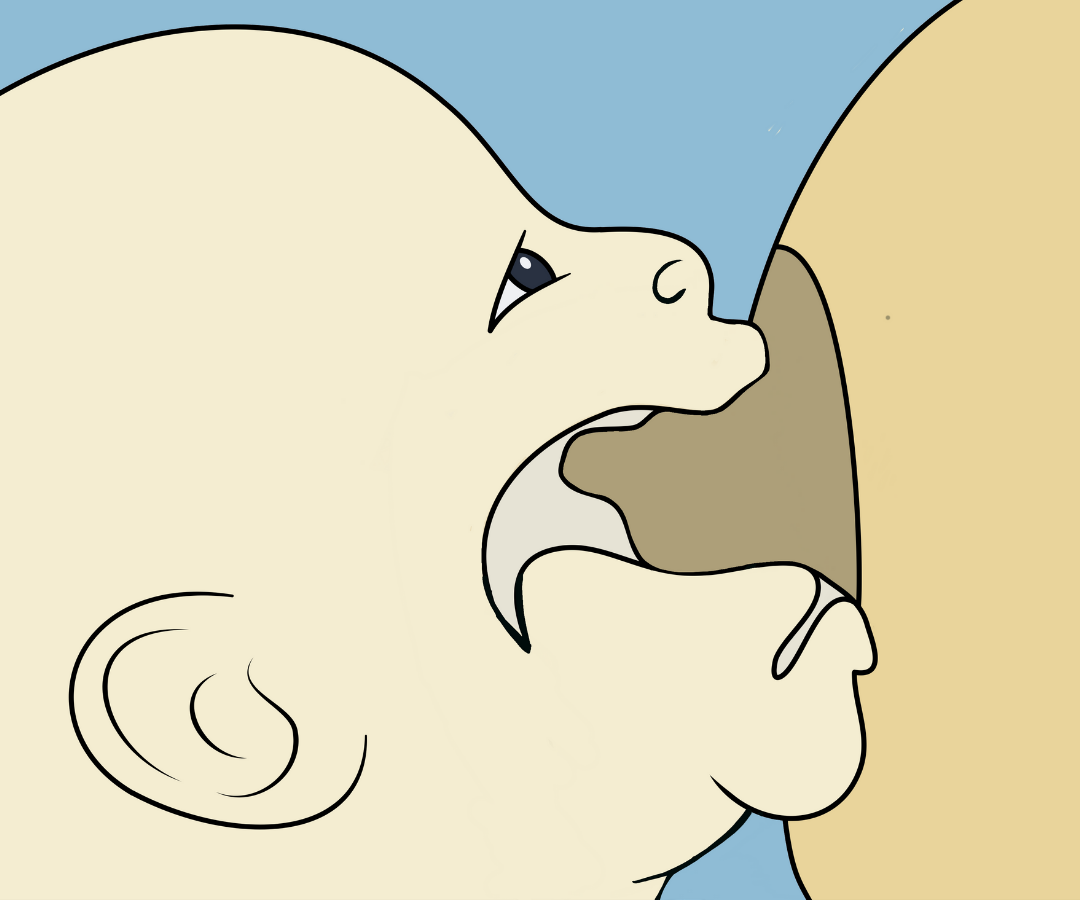
INSIDE THE MOUTH
When your baby takes your chest/breast into their mouth, they don't just take your nipple; they take your areola and breast/chest tissue into their mouth too. While your tissue significantly changes shape inside of your baby’s mouth, the bottle doesn’t. It no longer resembles your anatomy when it is inside your baby’s mouth.
The right bottle is the one that makes it easier for your baby to feed, regardless of what it looks like sitting on the shelf. None of the bottles that simply “look” like the breast are inherently better than bottles that don’t. Some of the self-described “more like the breast” bottles actually make it harder for a baby to feed, which you can learn about below. The idea that they are somehow better because they look like your breast is all marketing. No matter how warm and fuzzy you feel when you look at the baby bottles, the company isn’t actually trying to support your breastfeeding relationship. They are trying to sell their bottles, by using your desire to feed your baby at your chest/breast.
TIP # 2 - BABIES DRINK FROM A BOTTLE LIKE YOU DRINK FROM A STRAW.
Despite all of the marketing hype, no matter what bottle you choose, babies will always feed differently from the breast than they feed from a bottle. You use different oral muscles to drink from a cup than you do from a straw, and your baby uses different mechanics when drinking from the breast/chest versus a bottle.
There is no straw that you use that works ‘more like a cup’. There is no bottle nipple that works ‘more like a breast’ because they simply use two different muscle patterns. This is why many folks recommend waiting until your baby is breastfeeding well before using a bottle, when possible, so they can learn how to develop the muscles for breast/chestfeeding first.
TIP # 3 - ALL FEEDING WIRES YOUR BABY’S BRAIN
While you can not change how your baby feeds from a bottle, you can help to protect your choice in feeding your baby. Every time your baby feeds, they are wiring feeding behaviors to their brain. The more frequently your baby repeats behaviors that support breast/chest feeding, the more muscle memory the baby develops for those patterns. The same thing is true for unwanted feeding behaviors.
One important breastfeeding behavior that we can either support or undermine with a bottle is the gaping reflex - or the reflex that causes a baby to open their mouth widely at the breast. Many common breastfeeding problems (and pain) arise simply because a baby isn’t gaping widely to feed. Even if your baby starts off gaping widely at the breast, if they frequently use a narrow gape with a bottle, they become wired to have a narrow gape at the breast too. Helping your baby wiring gaping before ALL feeding can be supported by the bottle you choose and how you offer your baby a bottle.
Bottles are an important tool for most feeding parents. You don’t need a justification for their use on your feeding plan.
The baby in the first picture has a narrow gape with the bottle, while the baby in the second picture has a wide gape on the bottle.
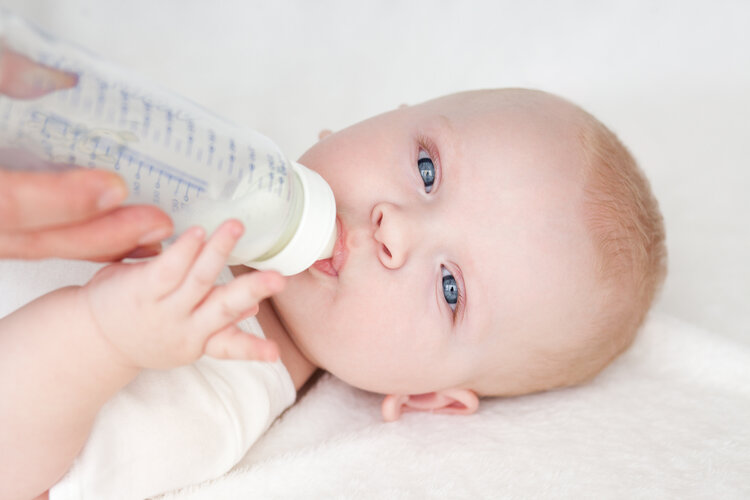
This baby has a narrow gape on the bottle. 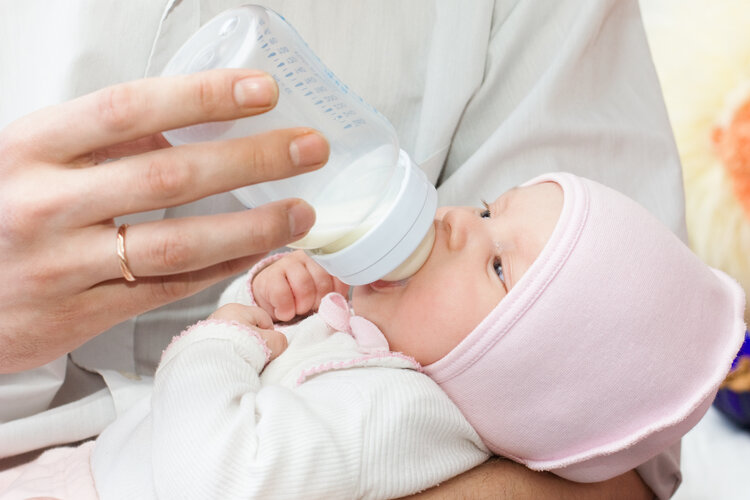
HOW TO SELECT A BOTTLE BASED ON SHAPE:
While you can not change how your baby feeds from a bottle, you CAN help to protect your choice in feeding your baby by selecting bottles that encourage your baby to open/gape widely at the breast/chest and have a slow flow rate.
To understand how to select a bottle that supports a wide gape, go back to the straw analogy. The mechanics of how you use suction to drink from a straw is very similar to how a baby uses suction to drink from a bottle. To generate suction, you use your tongue to stabilize the straw in your mouth. Imagine sucking from a straw a half an inch away from your tongue. It even feels awkward when thinking about it. You need your tongue to come into contact with the straw in order to suck effectively and safely, and your baby needs this too.
Consider these two bottles below. Both of the bottles are marketed as ‘better’ for breastfeeding.
BOTTLE 1 - ABRUPT TRANSITIONS FROM BASE TO TIP MAKES IT HARDER FOR A BABY TO GAPE WIDELY
In this bottle, there is an abrupt change between the base of the bottle and the nipple. When your baby gapes widely on this bottle so that their mouth is fully on the wide base, the nipple will be several millimeters away from their tongue, because of the abrupt transition. Babies will slide back on the nipple until it makes contact with their tongue. What may have started as a wide gape usually ends with a baby feeding just on just the tip of the nipple, with a very narrow gape instead.
Even though it may look more like a chest/breast, there isn’t anything about this bottle that makes it inherently better for a breastfeeding baby.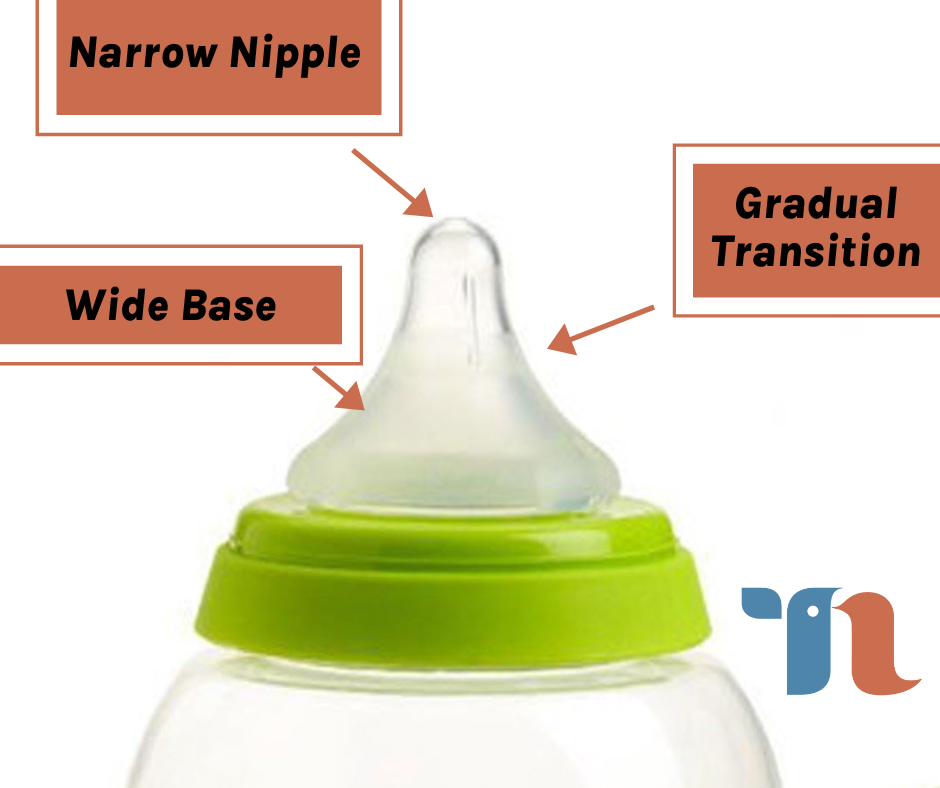
BOTTLE 2 - GRADUAL TRANSITIONS FROM BASE TO TIP MAKE IT EASIER FOR BABIES TO GAPE WIDELY.
In this bottle nipple, there is a gradual change between the base of the nipple and the tip of the nipple. No matter how widely the baby's mouth is open on the bottle, the tongue can easily contact the nipple. This allows a baby to have the widest gape that is comfortable for that baby, and still be able to generate suction.
Even though this nipple may look less idealized, the gradual shape allows the baby to practice --- and wire the brain for --- optimal breast/chestfeeding behaviors in a way that can't happen on the bottle in the first picture.
This bottle supports a wider gape, which does help a baby to be able to go between the breast and bottle.
HOW TO SELECT A BOTTLE BASED ON FLOW RATE
The other important factor to consider when selecting a bottle is the speed of the flow from the bottle. The faster the flow, the easier it is to remove liquid from the bottle - we can drink faster and more easily with a wide straw too.
Like we develop a preference for straw drinking because it is easier, a baby can develop a preference for the ease of a bottle too. This preference is at the root of the concept of “Nipple confusion”. Babies aren’t any more confused about the difference between an artificial nipple and the real thing than we are about straw and a cup. It simply takes less work to drink from a bottle than it does to drink from the breast, and babies can quickly get frustrated with a breast if the difference between the bottle and the breast is extreme.
One way to minimize the difference in the workload is to make sure that the flow of the bottle is slow. There are other good reasons to have a slow flow bottle as well, even if you are bottle-feeding your baby exclusively. Some babies need a slower flow to be able to coordinate sucking and swallowing safely.
Unfortunately, the term “Slow Flow” is relative, and no industry standard for bottle flow speed exists. The “slow flow” version of some bottles is much faster than the slow flow version of others. You can’t tell how fast a bottle is by looking at it on the shelf. In the next section, I’ll share a chart that compares the flow of some of my favorite bottles to help you with your bottle selection.
How slow of a flow your baby will need will depend on their age at birth (premie versus term), and their level of oral function, and how fast the flow of the feeding parent is. There isn’t a one-size-fits-all-babies approach when it comes to bottles.
You have likely discovered that they can come in a variety of flow rates, or age ranges. Breastfeeding babies don’t need to increase their flow rate from the bottle as they get older, as their feeding parent’s flow rate doesn’t change from birth. Most combo families don't need to worry about getting a variety of nipples to ‘age with them’ as they grow, you can stay with the same size nipple until they no longer need a bottle at all.
HOW TO CHOOSE THE RIGHT BOTTLE FOR YOUR BABY
Having THE RIGHT BOTTLE isn't something you need to cross off your list before birth. Bottles aren't the only (and likely not the best) way to get supplemental feedings into a breastfeeding newborn, if needed. If you need a bottle, the hospital will have some for you to use. If you are having a home birth, a prenatal consultation with a lactation consultant can help ensure that you have all of the tools you need to support feeding in the early days if breastfeeding gets off to a bit of a rocky start.
If you are expecting, it can be helpful to wait for your baby to arrive before opening and sanitizing your bottles, so that you can exchange them when you know more about the specific needs of your baby.
In addition to flow rate and shape, here are a few other things that may be important to your family in choosing the right bottle or your family.
GLASS VERSUS PLASTIC
Some families feel like glass bottles are really important because they are trying to avoid microplastics that shed into the bottles when it is prepared or shaken. You can read more about that here. The trade-off is that glass bottles are heavy and not all bottles come in small sizes. You may have to hack your bottle a bit to get just the right combination for you. The best strategy is to get the find the nipple that works for your baby and then find the glass bottle to match it.
BOTTLE SIZE
It may seem counter-intuitive but your baby doesn’t take much more from the breast at 6 weeks than they do at 6 months. The average intake volume for a breastfeeding baby is between 2-4 oz. Smaller bottles are easier to store, carry and use, and are generally large enough for most chest/breastfeeding babies for the duration of their bottle-using period. A 4-5 oz bottle is big enough for most breastfeeding babies, regardless of their age.
INTERCHANGEABLE BOTTLES
Some bottles are interchangeable with a variety of brands, so that you can keep the same base and simply swap out the nipples. That way, you will be able to find the one that works most specifically with your baby without collecting a plethora of bottles that you cannot use. Here is a website that has an easy-to-read chart that lets you see which bottle nipples are compatible with others, which is particularly helpful if you have bottles that your baby won’t use.
BOTTLES WITH ABRUPT CHANGE FROM BASE TO NIPPLE
In general, funky-shaped bottles and 'proprietary systems' and most aren’t gradually shaped. Some of the more popular bottles that fall in this category are Tommy Tippee, Nanobebe, Kiinde bottles, Avent Natural, and Comotomo. If you google “best bottle for breastfeeding” most of the hits that come up will be a bottle with an abrupt change. If you scrolled down to this section, read the section above to understand why the abrupt change bottles make it harder to gape at the breast/chest. This doesn't mean that these are bad bottles or that some babies don’t feed well from these bottles. It just means that bottles with an abrupt change from base to nipple often don’t support having a wide gape while feeding.
BOTTLES WITH A GRADUAL CHANGE AND A SLOW FLOW.
The chart below is a shortlist of bottles that have a gradual change and a slow flow. As with most things when it comes to babies, the bottle choice will be dependent on the individual needs of YOUR baby. There is rarely a one-size-fits-all approach, and there is no one perfect bottle.
I personally have found the Lansinoh Momma to be a solid choice because it has a consistent gradual shape, and it interchanges well with other brands. For example, a Lansinoh nipple fits on the 4 oz Avent glass bottle, which is helpful since the Lansinoh only comes in an 8 oz version, and that’s quite heavy for a glass bottle, and generally bigger than most breast/chestfeeding babies need. You can simply swap out the nipples to get the set-up you prefer.
The Lansinoh may not be the perfect solution for your baby because its flow is quite fast for a slow flow nipple, and some babies get overwhelmed by a faster flow. The Pigeon Peristaltic SS bottle has a slower flow than the Lansinoh but is expensive at around $15 per nipple on amazon. The Evenflow Balance doesn’t have quite the same base-to-tip shape as the Lansinoh, but has a slower flow and is inexpensive and generally more available.
The Dr. Brown Narrow (which has a different shape than Dr. Brown’s wide…why do bottles have to be so confusing?!) is somewhat gradual. While it isn’t my favorite bottle on the list for every baby, it is the only bottle on the list that comes in a premie flow (and ultra-premie), and that makes it a good option for babies who have significant oral function challenges or babies who come just a bit earlier than anticipated.
With any feeding, it is important to watch your baby for signs of distress or discomfort. A furrowed brow, chewing the nipple, milk leaking from the corners of the mouth, unusual sounds like clicking, sliding shallow on the nipple, unlatching or frequently turning their head to the side, and coughing or wheezing can all be indicators that the flow isn’t the right fit for your baby, or your baby is having a hard time feeding from a bottle. If you notice any of these behaviors, seek help from an IBCLC who has experience in oral function and can help to identify if your baby has any feeding challenges.



